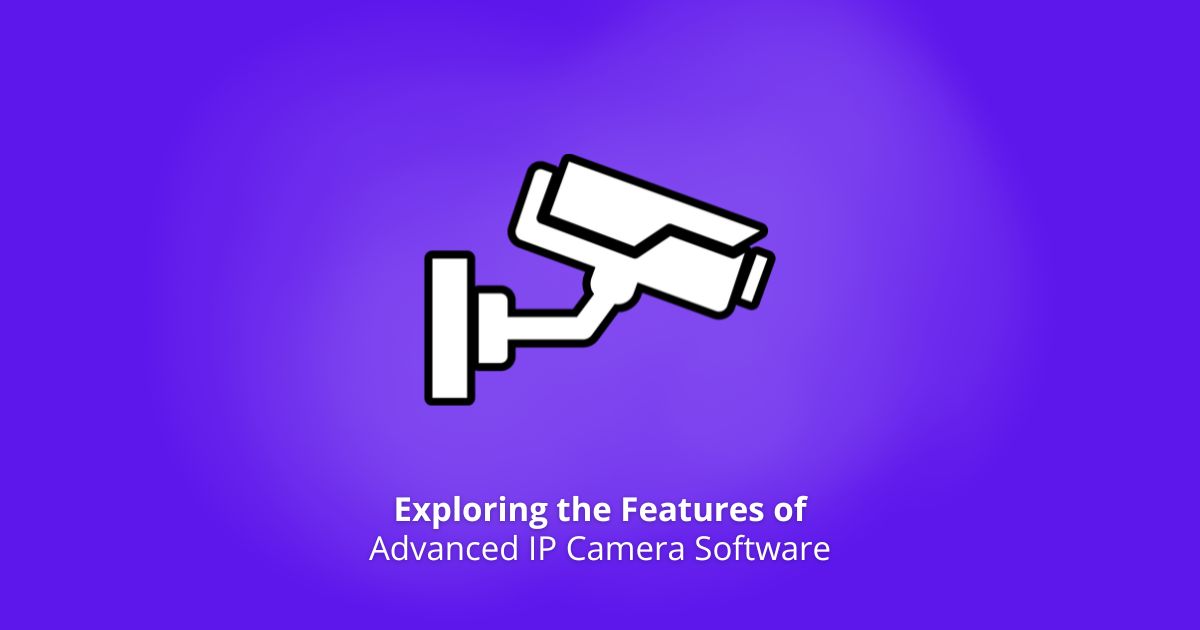Heightened security concerns and advanced surveillance needs give IP cameras have become an essential part of both personal and professional environments. However, the true potential of IP cameras is unlocked when paired with advanced IP camera software. These software solutions provide powerful tools to monitor, record, and analyze video footage efficiently.

Let’s dive into the essential features of advanced IP camera software and how they can revolutionize your security setup.
What Does IP Camera Software Do?
IP camera software is the central system that controls and manages IP cameras. They transmit video over an internet protocol network, enabling remote access and advanced analytics. The software acts as the brain of the operation, providing users with tools to monitor real-time video, manage multiple cameras, and leverage AI-driven insights.
There are free PC security camera software with some basic toolkit. And there are advanced options with more capabilities.
Key Features of Advanced IP Camera Software
1. Multi-Camera Management
Having all the cameras in front of you is great, isn’t it? IP camera programs help manage multiple connected devices from a single interface. Whether you are securing a small home or a sprawling enterprise, you can seamlessly connect and control numerous cameras across different locations.
Key tools often include:
- Customizable layouts for monitoring multiple camera feeds simultaneously
- Grouping features to organize cameras by location or type
- Scalability to add new cameras as needed
2. High-Quality Video Recording and Playback
Advanced IP camera software ensures that your video recordings are of the highest quality. Most platforms support HD and 4K resolutions, providing crystal-clear footage crucial for identifying faces, license plates, and other details.
Additional functionality:
- Frame-by-frame playback for detailed analysis
- Smart compression technologies to reduce storage usage without compromising quality
- Variable recording modes, such as continuous recording, event-based recording, or time-lapse recording
3. AI-Powered Analytics
AI integration is transforming the capabilities of anything, including IP camera tools. With machine learning algorithms, these systems can also analyze video footage in real time to detect and respond to specific events.
Some examples of what AI IP camera apps can do:
- Motion detection: Identify movements in restricted areas
- Object recognition: Recognize faces, vehicles, or unattended objects
- Behavior analysis: Detect suspicious activities like loitering or sudden crowd gatherings
4. Remote Access and Mobile Integration
Modern IP camera apps allow you to monitor and control your cameras from anywhere. All you need is the internet and access. Through mobile apps or web interfaces, you can enter live feeds, review recordings, and even control camera angles remotely.
Key benefits include:
- Push notifications for alerts, like motion detection or camera tampering
- Two-way audio communication for cameras equipped with microphones and speakers
- Cloud-based storage options for accessing footage on the go
5. Smart Alerts and Notifications
Gone are the days of sifting through hours of footage to find an event. Advanced software can send immediate alerts for predefined triggers, such as movement in a secure zone or a break-in.
Smart notifications are customizable, enabling you to set:
- Specific times and zones for alerts
- Sensitivity levels for motion detection
- Alert types such as emails, SMS, or app notifications
6. Cloud and Local Storage Options
Storage flexibility is a vital feature of any IP camera software. Advanced systems allow you to choose between local storage (using hard drives or NAS devices) and cloud storage.
Why pick cloud storage:
- Automated backups to avoid data loss
- Encryption protocols to secure sensitive footage
- Retention settings to manage storage space by automatically deleting older footage
7. Advanced Privacy and Security Features
With cameras connected to networks, data security is the highest priority. Innovative IP camera programs includes robust privacy controls to protect your data from breaches and unauthorized access.
For example:
- End-to-end encryption for video streams
- User authentication protocols like two-factor authentication
- Access control settings to restrict certain users or devices
8. Integration with Smart Home Systems
Many options integrate seamlessly with smart home ecosystems. This allows you to connect your cameras to systems like Amazon Alexa, Google Home, or Apple HomeKit for enhanced automation and control.
- Automate lights or alarms based on camera triggers
- Use voice commands to view live feeds on compatible devices
- Synchronize cameras with other IoT devices for comprehensive home automation
How to Choose the Right IP Camera Software
When selecting IP camera software, consider the following factors:
- Compatibility: Ensure it supports your existing cameras and devices.
- Ease of Use: Look for intuitive interfaces and simple setup processes.
- Features: Choose software that matches your security needs.
- Budget: Compare pricing plans, especially if there are subscription-based nuances (for example, for cloud storage space)
- Support: Opt for an app with reliable customer support and regular updates.
Conclusion
Advanced IP camera software changes modern surveillance systems immensely, offering a range of features that help in diverse security requirements. From AI-driven analytics and smart alerts to seamless integration with other devices, these solutions enhance safety and efficiency for homes and businesses alike.